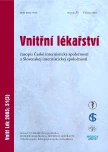Chronic critical limb ischaemia – distal revascularisation vs distal revascularisation with free muscular transfer
Authors:
B. Zálešák 1; P. Tošenovský 2; I. Čižmář 3; J. Zapletalová 4; M. Šimek 5
Authors‘ workplace:
Klinika popálenin a rekonstrukční chirurgie Lékařské fakulty MU a FN Brno, pracoviště Bohunice, přednosta prof. MUDr. Pavel Brychta, CSc. a oddělení plastické a estetické chirurgie FN, Olomouc, přednosta MUDr. Pavel Hartl
1; Klinika transplantační chirurgie IKEM, Praha, přednosta doc. MUDr. Miroslav Ryska, CSc.
2; Oddělení úrazové chirurgie, FN Brno, pracoviště Bohunice, přednosta doc. MUDr. Michal Mašek CSc.
3; Ústav biofyziky a biometrie Lékařské fakulty UP, Olomouc, přednosta prof. Ing. Jan Hálek, CSc.
4; Kardiochirurgická klinika Lékařské fakulty UP a FN, Olomouc, přednosta doc. MUDr. Petr Němec, CSc.
5
Published in:
Vnitř Lék 2005; 51(3): 292-298
Category:
Original Contributions
Overview
The study compares treatment results in two groups of patients with critical limb ischaemia:
the group A – 21 patients treated only with the pedal bypass is compared with the group B – 17 patients treated with the pedal bypass and free microsurgical muscular transfer covered with dermoepidermal graft. Primary/secondary one-year patency in the first group was 64.7/82.4% and 54.5/81.8% in the second group, respectively. Evaluation of the patency at the end of the study by means of the survival analysis together with construction of Kaplan-Meier survival curves and long-rank test did not prove significantly relevant difference between the two groups (p = 0.14). No statistically significant differences were found even in the number of relapses, amputations and deaths. Even though combined surgery is incomparably more demanding for surgical team, it represents substantially higher stress for a patient and it is performed in conditions of more extensive peripheral affection of the limb than pedal bypass only, it is not related with the higher number of relapses, amputations nor higher mortality. It is unjustifiable to deny this surgery to the patients in higher age groups with associated diseases and to use possible risks of this demanding surgery as a reasoning of the denial. Pedal bypass and muscular transfer represent the last possibility of saving a limb and keeping bipedal walking for these patients.
Key words:
critical ischaemia – pedal bypass – free muscular flap – preservation of the limb
Sources
1. Jirkovská A, Wosková V, Kobilková J et al. Onemocnění nohou u diabetiků a péče o dolní končetiny. Praha: IKEM 1992.
2. Gensler SV, Haimovici H, Hoffer P et al. Study of vascular lesions in diabetics, nondiabetic patients. Arch Surg 1967; 95: 918.
3. LoGerfto FW, Coffman JD. Vascular and microvascular disease of the foot in diabetes. N Engl J Med 1984; 311(25): 1615–19.
4. Gutman M, Kaplan O, Skornik Y et al. Gangrene of the lower limbs in diabetic patients: A malignant complication. Am J Surg 1987; 154(3): 305–309.
5. Bodily KC, Burgess EM. Contralateral limb and patient survival after leg amputation. Am J Surg 1983; 146(2): 280–282.
6. Kucan JO, Robson MC. Diabetic foot infections: Fate of the contralateral foot. Plast Reconstr Surg 1986; 77(3): 439–41.
7. High RM, McDowell DE, Sawrin RA. A critical review of amputation in vascular patients. J Vasc Surg 1984; 1(5): 653–5.
8. Ouriel K, Fiore WM, Geary JE. Limb threatening ischemia in medically compromised patient: Amputation or revascularization? Surgery 1988; 104(4): 667–72.
9. European Working Group on Critical Leg Ischaemia. Second European consensus document on chronic critical leg ischaemia. Eur J Vasc Surg 1992; 6(Suppl A): 1–32.
10. Tosenovsky P, Zalesak B, Janousek L et al., Pedální bypass v léčbě ischemie diabetické nohy, Rozhl Chir 2002; 81(1): 118–21.
11. Tosenovsky P, Zalesak B, Janousek L et al. Microvascular steal syndrome in the pedal bypass and free muscle transfer? Eur J Vasc Endovasc Surg 2003; 26(5): 562–564.
12. Tošenovský P, Zálešák B, Adamec M et al. Pedální bypass v léčbě ischemie diabetické nohy. Rozhl Chir 2002; 81(1): 18–21.
13. Marusiak J, Strincl J, Rambousek Z et
al. Periferní revaskularizace dolních končetin u pacientů s kritickou končetinovou ischemií. Rozhl Chir 1998; 77(4): 179–184.
14. Zálešák B, Tošenovský P, Trupár E et al. Záchrana končetina ohrožené kritickou končetinovou ischemií kombinovaným výkonem. Bulletin HPB 2003; 11(1): 25–28.
15. Dražan L. Léčení diabetické nohy s pomocí mikrochirurgie: Závěrečná zpráva Grant IGA MZ ČR ND 5219–3.
16. Staffa R, Leypold J, Kříž Z. Význam pedálního bypassu při záchraně končetiny. Role of Pedal Bypass Grafting in Limb Salvage. Rozhl Chir 2004; 83: 24–30.
Labels
Diabetology Endocrinology Internal medicineArticle was published in
Internal Medicine

2005 Issue 3
Most read in this issue
- Hyperphosphataemia as an important complication of chronic renal insufficiency and chronic renal failure, part 1 – etiopathogenesis, consequences and diagnostics
- Hyperphosphataemia as an important complication of chronic renal insufficiency and chronic renal failure, part 2 – treatment
- Novel findings on iron metabolism
- Diabetic cardiomyopathy
